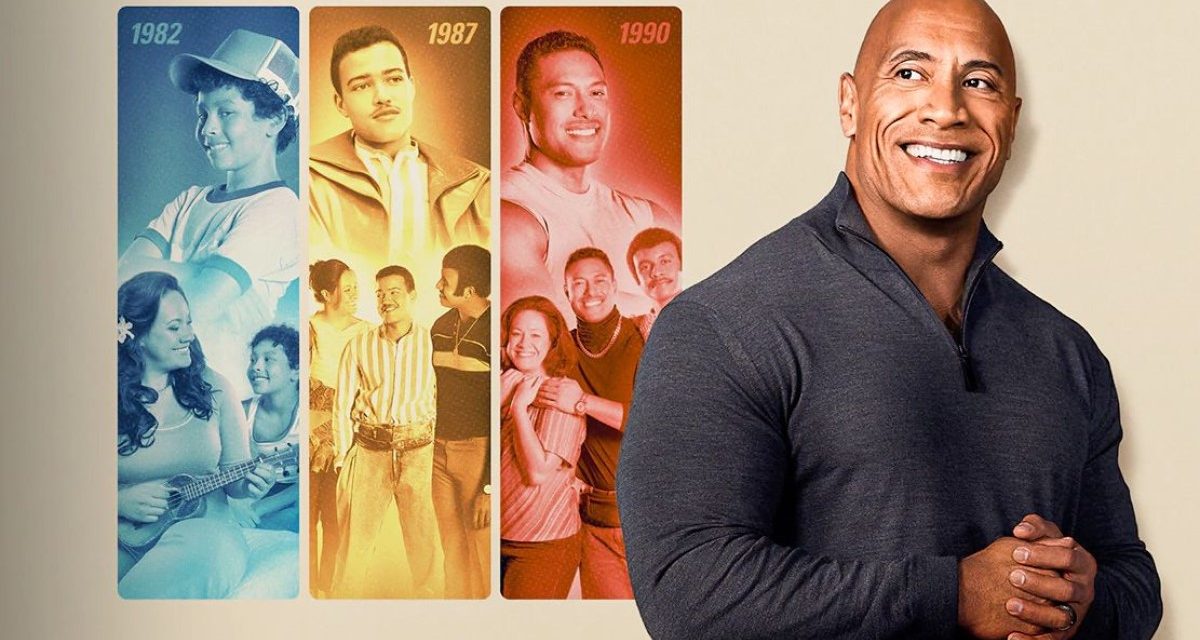When Slam Wrestling had the opportunity to speak with Brian Gewirtz, executive producer of NBC’s Young Rock and former WWE writer, it became clear pretty early on that he enjoys his role as a behind-the-scenes creative worker.
You won’t find his picture on the Seven Bucks Production website, despite having a hand in several of the company’s productions after being brought into the Dwayne Johnson-led company as Senior Vice-President of Development in 2015. A general internet search won’t do you much good, either; you’ll mostly see a picture of Gewirtz from a Viacom industry panel making the rounds as a go-to featured image of the writer.
Not that he likes it. He refers to the picture, in fact, as “the bane of my existence.” So, indeed, Gewirtz prefers to be behind the camera.
In the second part of Slam Wrestling’s interview with Gewirtz (check out part one about his work on Young Rock here), he digs into his past of working behind the curtain of the WWE: what a day at the office really entailed, and how his transition to Seven Bucks Productions came about.
“If you’re expecting a certain amount of stability and predictability — you might be in the wrong line of work,” Gewirtz opens, plainly setting the table for a description of life as a WWE writer. He describes his first few years writing for Raw and SmackDown, which began in earnest in 1999, as having a truly “wild west” feeling and energy about them.
Coming from TV sitcom writing, as he had worked on the short-lived shows Claude’s Crib and Jenny, Gewirtz arrived with some experience-based notions that were upended by the way the then-WWF shows of that time were produced.
“I had assumed that the shows are going to be written, like they are today, well in advance, but back then it was very, very much on the fly,” Gewirtz recalls. “Now, it is very structured and segmented. There’s a home team and there’s an away team, and there’s people who write specifically the day of the show, and people who write the first version of it, et cetera. But when I started it was me and the McMahons and a writer named Tommy Blacha, who had just come over from Conan. We would get to (Monday Night Raw), and then drive with the McMahons to the next town, get up at 7 a.m. the next day, and start from scratch and write SmackDown.”
“It certainly wasn’t a typical nine to five job.”
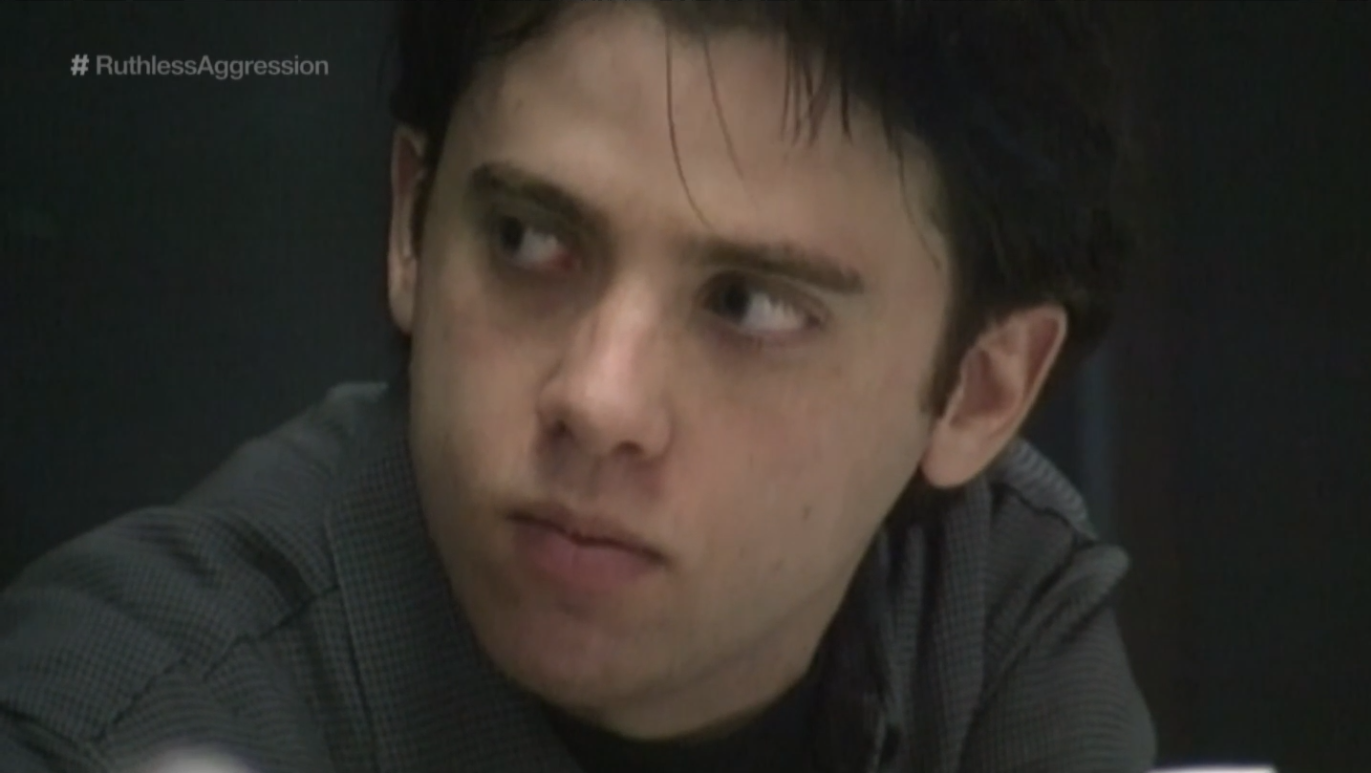
Years before working in Young Rock, here’s young Brian Gewirtz in the WWE’s writers’ room in a still from the WWE Network’s documentary series Ruthless Aggression.
Gewirtz details how the creative process evolved over time, thanks to the success of the WWE coming out of the Monday Night Wars, which both facilitated and necessitated a more structured manner of creative operations. “You can’t maintain that level of chaos — structure eventually found itself,” he explains. “Ultimately it evolved and we’d have drafts of shows fully written out, not word for word but certainly segment by segment.”
“It was an evolving process where we’re starting to have more meetings, then we’d start to have weekend meetings with Vince going over the scripts, then we split the writing teams around 2002 or so (for the brand split between Raw and SmackDown). And that took some time.”
Gewirtz learned another part of the “expect the unexpected” lifestyle that working for the WWE required as he tried to juggle his home and business life. “When I first started, WWE moved me into Stamford, Connecticut,” he begins. “I found that we weren’t going to the office — we were actually faxing our ideas to Vince’s office, showing up at TV and hoping he’d use them. So I subletted my Stamford apartment and moved to New York City, which is what I always wanted to do. Then literally, once the lease was signed, I was told we would be meeting in Stamford. Of course.”
Things like that were something of a minor inconvenience compared to the full-blown upheaval of plans due to instances such as injury. “You know going in that plans are going to change and that people, invariably, are going to get injured,” he says. “There’s going to be a 30 Rock kind of monkey wrench that’s going to put the day in a tailspin, but you adjust.”
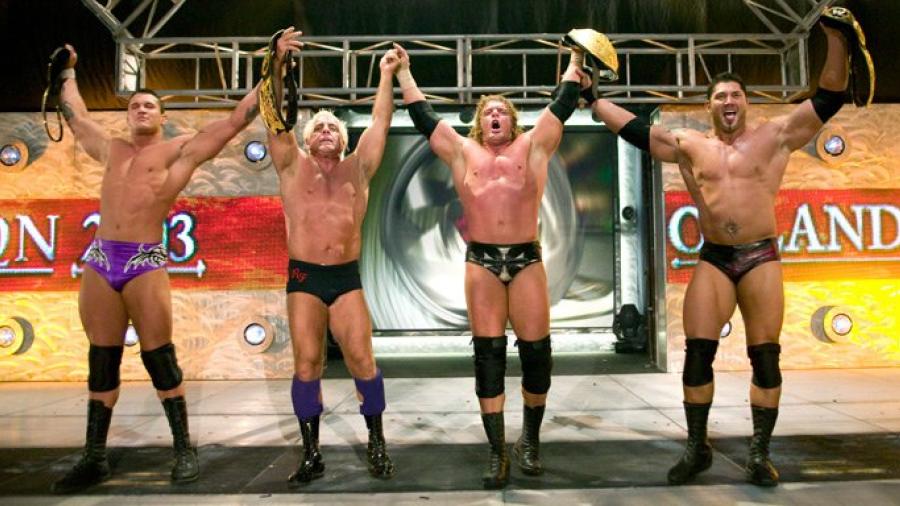
Gewirtz recalls how Evolution, here at the height of its success, ran into a stumbling block early on. Photo: WWE
“We’ve got this great angle with Batista and Randy Orton, and then hearing: ‘Wait a minute, they got injured in the same match on a live event, so we have to rewrite the show,’” Gewirtz recalls, looking back on a match from March of 2003 in Reading, PA, that stalled the Evolution stable’s early stages. Bubba Ray Dudley, incidentally, was also injured in the match, at which point one would have to presume that the wrestling gods were simply displeased that night.
And yet, beyond those types of invariables that certainly happen less frequently in traditional television programming (our more seasoned readers may remember, for one example, Erik Estrada filming some scenes for the 70s/80s show CHiPs from a hospital bed while he legitimately recovered from an on-set injury), Gewirtz points to one thing that the WWE has going for it that most TV shows can only dream of.
“The WWE, unlike a lot of sitcoms and hour-longs, is always going to be on the air,” he explains. “It’s not going to be cancelled any time soon.”
Once Gewirtz became accustomed to the high-speed creative machinations of his new job, he then settled into the structure that allowed for partnerships to be tested and then formed between the writers and the wrestlers. “We’d sort of divvy (the work) up with people that we were naturally closer with,” he begins in answer to whether writers specialized in working with certain wrestlers. “Michael Hayes and Paul Heyman, the veterans, would talk to the more veteran people; I would talk to the younger talent, and The Rock too, who was pretty young himself.”
“WWE has always benefited from collaboration and has always benefited from not handing a person a piece of paper and saying, ‘This is what you’re going to do,’” Gewirtz continues. “We’d have our list of people that we would call over the weekend, and essentially tell them what was coming up on TV. But the best process is always being able to sit down, when there’s time, and say, ‘Here’s what we’ve got. Here’s the premise, how would you say this?’, or at the very least, ‘While you guys go over your match, I’m going to put a first version of this together. And then, we’ll all sit down in the locker room or in catering or wherever and go over it and you’ll be able to give your feedback and I can make changes to it.’”
“All of The Rock’s promos were always a great process of Dwayne being able to take ideas or take lines and craft it into a great promo. It’s so important that the talent be invested, and to have a say in what they’re doing.”
Sometimes that connection was natural, as Gewirtz notes, but sometimes it took a little time to build a rapport. Especially if you grew up booing the person you’re writing for. “It’s vivid in my memory, sitting down with Chris Jericho and Shawn Michaels to go over all of their promos,” he says, but continues with a chuckle. “I wasn’t a huge Shawn Michaels fan — I was always rooting for the Harts. But that’s something Stephanie was always trying to get us to do: step out of our comfort zone and work with people that we hadn’t worked with before.”
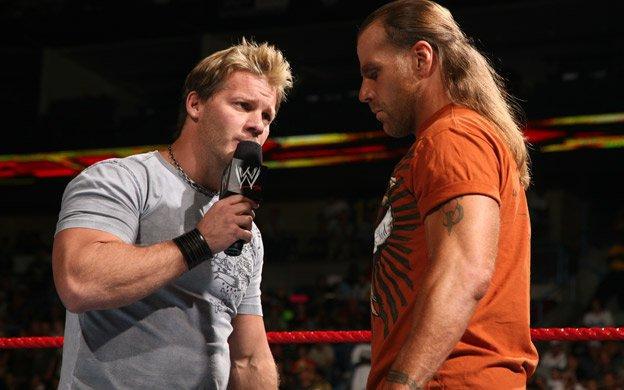
Chris Jericho and Shawn Michaels working together in 2008. Photo: WWE
When asked about writing assignments or professional partnerships that simply didn’t work, Gewirtz acknowledges that there are always some relationships that work better than others. “Sometimes you’ll find certain people click, and certain people don’t, and stepping out of your comfort zone is great but if another writer clicks more with another person, then don’t fight the tide.”
Although Gewirtz, now more than five years removed from employment with the WWE, doesn’t mind playfully taking some storytelling decisions to task via his Twitter account, he evidently is not interested in dishing out times when he found it challenging to work with any particular wrestlers. “I try to focus more on the positive,” he offers, instead of detailing any strife he may have encountered. That attitude has the ring of a man comfortable with his career in the WWE, and not looking to harbour old grudges in an industry practically built upon them. He also expressed a touch of wisdom gained through experience as he reflects upon fits of passion in his past that don’t seem so important now.
“You’re always sort of taking it as life or death at the time as far as this finish has to happen or we need to go this way,” he says. “And then, you know, years later, you’re like, ‘Why was I so hung up on this or that kind of thing?’ I vaguely remember, and I’m dating myself, wanting the Kurt Angle, Triple H, and Stephanie love triangle to end differently and go in a different direction. But there are so many variables that go on and it’s not a simple matter of writers suggesting ‘this’ and then you do it. It needs to not only work in a vacuum in terms of that particular story but where you’re going in the future. It’s a domino effect. If someone turns babyface, who’s going to take their spot as the next babyface?”
Staying on the positive side of the street, Gewirtz is more than happy to throw some praise to a current championship-calibre wrestler that he, quite frankly, never saw headed for that level of success: The Miz. “It’s not that I didn’t think that he would succeed, but I didn’t really get his whole deal,” he recalls. “I didn’t watch The Real World. I didn’t really know much about him. The perseverance that he showed when everyone literally cast him out of the locker room at one point, it was like a pleasant surprise to be able to then see him go to main-eventing WrestleMania with John Cena and The Rock. Once you get to know the person and work with them, you realize they had it in them all along.”
This point brings our discussion to the time when Gewirtz was looking to accomplish everything that he has had in himself all along, and after over ten years writing for the ring, he knew there were other things calling to him. “At a certain point, you start to get an itch to do more,” he states. “WWE, to their credit, tried ways that I could do that, in terms of being able to write some screenplays for WWE Films — that was great. In other cases, it was taking on more management type roles, which wasn’t something that I actually was feeling. I was getting an itch to do something else, and around the same time Dwayne and Dany (Garcia) were starting up Seven Bucks.”
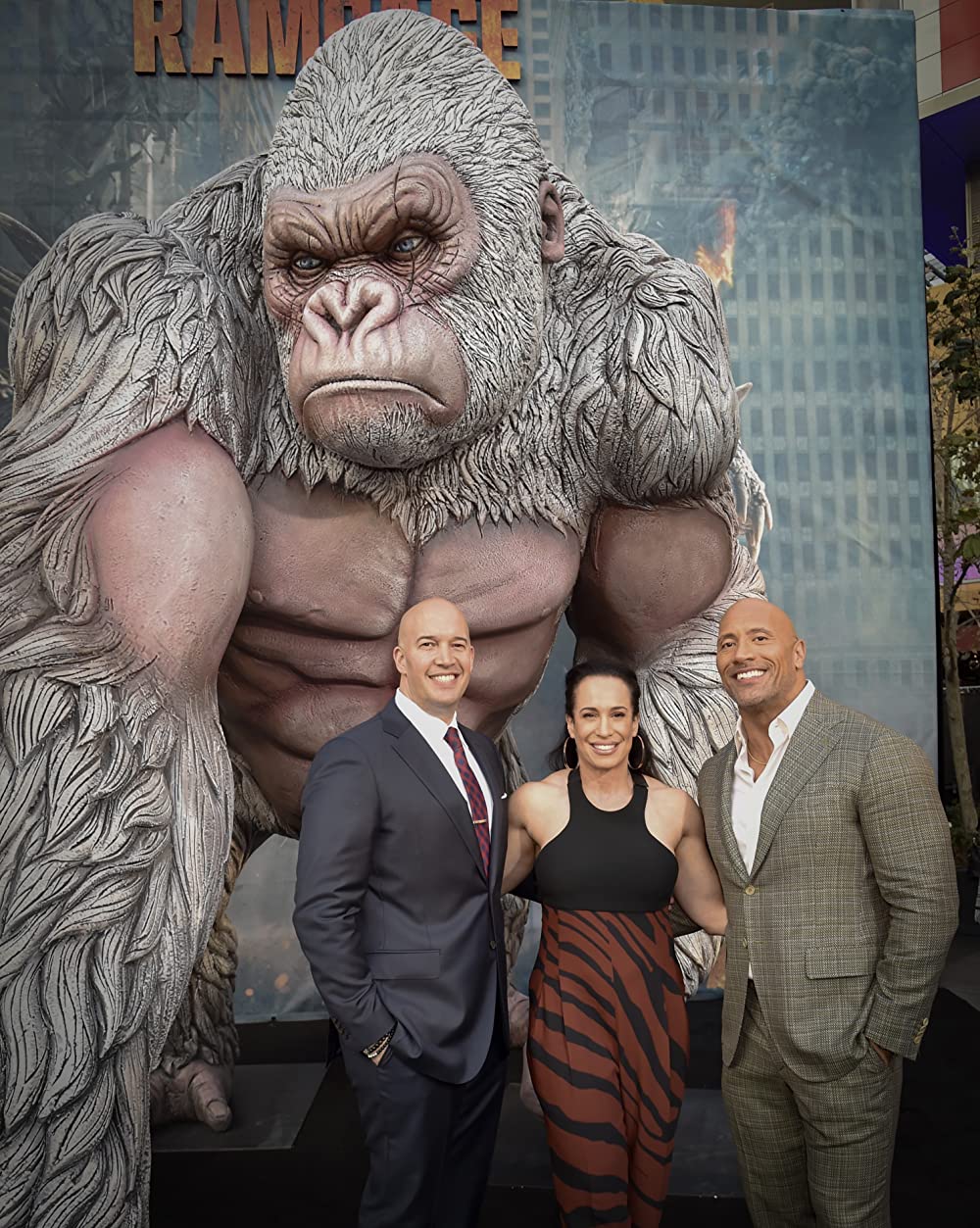
Seven Bucks Productions is represented by Hiram Garcia, Dany Garcia, and Dwayne Johnson at the Rampage film premiere. Photo: IMDB
There is a certain serendipity to the connection with Johnson that first brought Gewirtz into the WWE, and was now offering an avenue to depart the WWE for new challenges. “In 2012, I reached an agreement, despite what I read about on wrestling sites,” Gewirtz explains, referring to sites not named Slam Wrestling. “I had reached an agreement with WWE that allowed me to work there part-time as a consultant while working at Seven Bucks part-time as well. It was the perfect way to do it. As Seven Bucks expanded, and were ready to take me on full-time, I was able to make the transition in 2015 having already done the job on a part-time basis for two and a half years at that point.”
“WWE was totally accommodating. Stephanie specifically was like, ‘I know this is something you’ve wanted to do for a long time,’ so they couldn’t have been more supportive.”
Moving forward, if Gewirtz operates according to his past, he may have about a decade of work to do with Seven Bucks before he feels another itch. For now, keep checking the credits and you’ll likely see him steadily at work — but comfortably behind the camera only.
MORE BRIAN GEWIRTZ STORIES
- Sep. 6, 2022: Gewirtz’s book an honest look at WWE’s creative process
- Aug. 28, 2022: Former WWE writer Gewirtz talks about his book
- Apr. 6, 2021: Brian Gewirtz brings his own wrestling acumen to ‘Young Rock’ as executive producer
RELATED LINKS
- NBC’s Young Rock page
- Seven Bucks Productions official website
- Dwayne ‘The Rock’ Johnson and family story archive
- Slam Wrestling’s Young Rock review and interview archive
